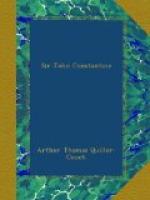Plainly she was standing-by, waiting; plainly then her crew—or those of them engaged for the assault—were detained yet upon the island; whence (to make matters surer) there sounded, as our boat ran up to it, a few loose dropping shots and a single cry—a cry that travelled across to us down the lane of light directing us to the quay. The blaze had died down; the upper keep, now overhanging us, stood black and unlit against a sky almost as black; but on a stairway at the base of it torches were moving and the flame of them shone on the slippery steps of a quay to which I guided the boat. There, jamming the helm down with a thrust of the foot, I ran forward and lowered sail.
We carried more way than I had reckoned for, and—the Princess having no science to help me—this brought us crashing in among a press of boats huddled in the black shadow alongside the quay-steps with such force as almost to stave in the upper timbers of a couple and sink them where they lay. No voice challenged us. I wondered at this as I gripped at the dark dew-drenched canvas to haul it inboard, and while I wondered, a strong light shone down upon us from the quay’s edge.
A man stood there, holding a torch high over his head and shading his eyes as he peered down at the boat—a tall man in a Trappist habit girt high on his naked legs almost to the knees.
“My father?” I demanded. “Where is my father?”
He made no answer, but signed to us to make our landing, and waited for us, still holding the torch high while I helped the Princess from one boat to another and so to the slippery steps.
“My father?” I demanded again.
He turned and led us along the quay to a stairway cut in the living rock. At the foot of it he lowered his torch for a moment that we might see and step aside. Two bodies lay there—two of his brethren, stretched side by side and disposedly, with arms crossed on their breasts, ready for burial. High on the stairway, where it entered the base of a battlemented wall under an arch of heavy stonework, a solitary monk was drawing water from a well and sluicing the steps. The water ran past our feet, and in the dawn (now paling about us) I saw its colour. . . .
The burnt building—it had been the Genoese barracks—stood high on the right of the stairway. Its roof had fallen in upon the flames raging through its wooden floors, so that what had been but an hour ago a blazing furnace was now a shell of masonry out of which a cloud of smoke rolled lazily, to hang about the upper walls of the fortress. Through its window-spaces, void and fire-smirched, as now and again the reek lifted, I saw the pale upper-sky with half a dozen charred ends of roof-timber sharply defined against it—a black and broken grid; and while yet I stared upward another pair of monks crossed the platform above the archway. They carried a body between them—the body of a man in the Genoese uniform—and were bearing it towards a bastion on the western side, that overhung the sea. There the battlements hid them from me; but by-and-by I heard a splash. . . .




